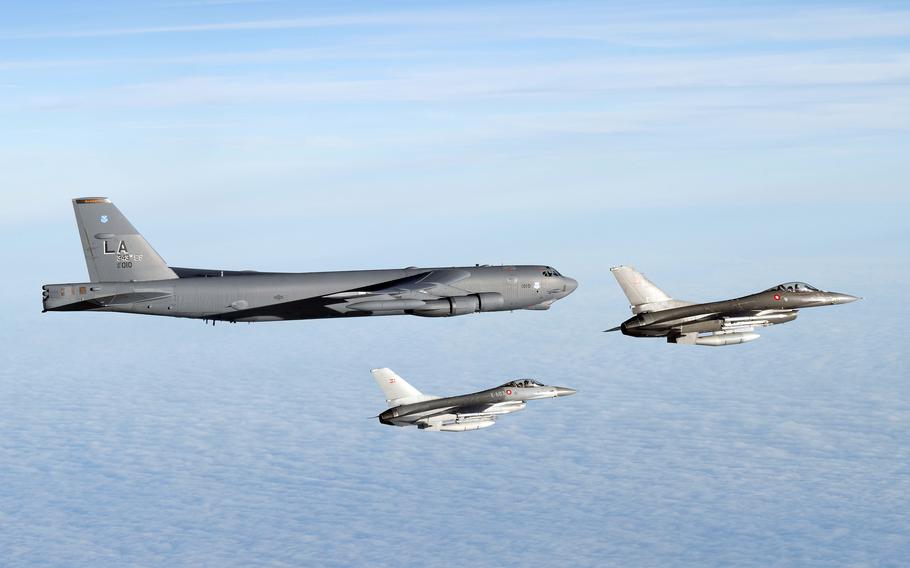
A U.S. Air Force B-52H Stratofortress is escorted by two Danish air force F-16 Fighting Falcons over the Baltic Sea in November 2024. Should the Pentagon withdraw from Europe and force European allies to take over conventional defense of the Continent, across-the-board military deficiencies would result, according to an International Institute for Strategic Studies report released May 15, 2025. (Jacob Cabanero/U.S. Air Force)
STUTTGART, Germany — A rapid U.S. military withdrawal from Europe would leave allies on the Continent exposed to attack and cost them hundreds of billions of dollars to offset the loss of American firepower, a new report says.
The International Institute for Strategic Studies think tank estimates that it would cost Europe between $226 billion and $344 billion to match U.S. conventional weapons systems and platforms that play a central role in the Continent’s defense.
Over a 25-year life cycle, including maintenance costs, that figure could grow to more than $1 trillion, according to the report released Thursday.
Replacing American troops stationed in Europe and those who would be expected contribute to NATO defense plans in a conflict would cost $12.3 billion annually, the report said.
The study looked at the implications of a large-scale Pentagon pivot to Asia in 2025 that would remove most U.S. military assets from Europe. Roughly 80,000 American troops now operate across the Continent.
The report also considered the possibility of Russia rebuilding its military in the coming years if a lasting ceasefire is reached with Ukraine.
“In such a scenario, there may not be much time to prepare for a Russian threat to allied territory,” the report said, adding that Europe would face a considerable “window of vulnerability” in the short term without American support.

German and Spanish air force planes fly in formation over the German navy frigate Baden-Württemberg as it leaves Naval Station Rota in Spain on May 7, 2024. A U.S. military withdrawal from Europe would cost allies hundreds of billions of dollars to offset the loss of American firepower, the International Institute for Strategic Studies said in a report released May 15, 2025. (Ryan Brown/U.S. Navy)
The report comes amid uncertainty about the future U.S. role in European defense and the level of continued American involvement in NATO.
President Donald Trump hasn’t laid out his vision for the U.S. European Command mission, though several top Pentagon officials have said Europe must prepare to handle conventional defense on its own.
The Defense Department has said it is reviewing global force posture but hasn’t announced any plans for a large withdrawal from Europe this year in line with the report’s scenario.
But the expectation is that while the United States would continue to provide NATO’s nuclear deterrent, European countries would need to assume primary responsibility for conventional forces so the Pentagon can focus on countering China’s rising military.
The circumstances have created angst among many allies who fear that an abrupt American withdrawal looms.
The forces Europe could develop fastest are on the ground, the report stated. Growing those forces and their weapons would cost between $51 billion and $93 billion, according to the report.
Still, to fully match what U.S. ground forces can do in Europe would take a decade, IISS said.
Air power would be the costliest to replicate, with a price tag of between $88 billion and $125 billion. Added naval systems were similar in cost, ranging between $86 billion and $125 billion.
European nations have already increased defense spending in recent years in response to Russian aggression and U.S. pressure to meet alliance targets. But with uncertainty about the level of future U.S. commitment, key allies are preparing to spend significantly more.
Germany, which had long resisted ramping up military spending, last year hit NATO’s benchmark of spending 2% of gross domestic product on defense.
On Thursday, German Foreign Minister Johann Wadephul said Berlin is prepared to meet Trump’s new demand of increasing the spending threshold to 5% of GDP.
Even with larger budgets, IISS said the timeline for building new systems and developing military-industrial infrastructure means improved capabilities won’t arrive quickly.
To close the current defense gap, European policymakers will need to prioritize countering Russia’s anti-access and area denial tools, such as long-range air defenses and surface-to-surface missile systems, the report said.
That would involve more air and missile defense, air-launched precision weapons, rocket artillery and ground-launched precision strike platforms.
“Closing the window of vulnerability in the short term without a U.S. presence would thus be very challenging,” the report said. “However, rebuilding European defense capacity in the medium term would not be an impossible task.”